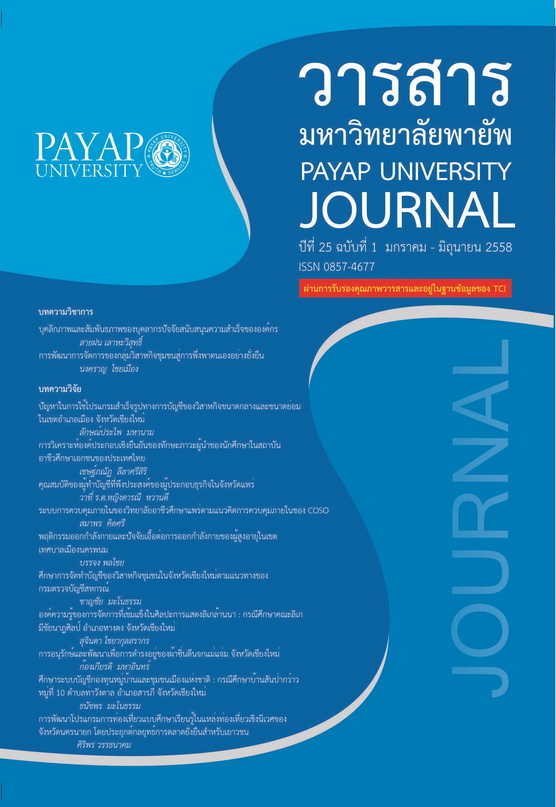องค์ความรู้ของการจัดการที่เข้มแข็งในศิลปะการแสดงลิเกล้านนา: กรณีศึกษาคณะลิเกมีชัยนาฏศิลป์ อำเภอหางดง จังหวัดเชียงใหม่
Main Article Content
บทคัดย่อ
การวิจัยนี้เป็นการวิจัยเชิงคุณภาพ มีวัตถุประสงค์เพื่อศึกษาประวัติความเป็นมาของลิเกล้านนารูปแบบศิลปะการแสดงของลิเกคณะมีชัยนาฏศิลป์ อำเภอหางดง จังหวัดเชียงใหม่ และถอดองค์ความรู้ของการจัดการที่เข้มแข็งในศิลปะการแสดงลิเกล้านนาของคณะลิเกมีชัยนาฏศิลป์ ที่ดำเนินงานแสดงลิเกมามากกว่า 68 ปีและยังคงดำเนินการอยู่ โดยศึกษาเอกสารงานวิจัยที่เกี่ยวข้องกับลิเกและลิเกล้านนา ใช้การสัมภาษณ์เชิงลึกจากผู้มีส่วนเกี่ยวข้องโดยตรงกับลิเกล้านนาและคณะลิเกมีชัยนาฏศิลป์ ผลการวิจัยพบว่า ลิเกล้านนารับศิลปะการแสดงลิเกมาจากภาคกลางโดยครูสะอิ้ง โสพิศ และเกิดเป็นคณะลิเกล้านนา ที่มีเอกลักษณ์ของตนเอง คือ การเจรจาด้วยภาษาล้านนา ใช้เพลงพื้นเมือง จ๊อย ซอในการแสดง เรื่องที่แสดงใช้เรื่องชาดกนอกนิบาตหรือเรื่องธรรมพื้นเมือง สำหรับลิเกมีชัยนาฏศิลป์ ก่อตั้งโดยนายบุญมี ใบงิ้ว ตั้งแต่ปีพ.ศ.2498 ต่อมาภายหลังนายบุญมีอายุมากขึ้นลูกๆจึงดำเนินการต่อ ปัจจุบันนายเจริญ ใบงิ้ว และนางทิตยา พฤฒิศิลป์ โอโน ลูกชายและลูกสาวเป็นผู้บริหารจัดการ โดยรูปแบบการแสดงที่ยังคงเอกลักษณ์ของลิเกล้านนา จากการวิจัยพบองค์ความรู้ของการจัดการที่เข้มแข็งของคณะลิเกมีชัยนาฏศิลป์ประกอบด้วย
1. องค์ความรู้ด้านการแสดงที่สร้างความพึงพอใจให้กับผู้ชม ที่สอดคล้องกับแนวคิดและทฤษฎีความพึงพอใจ ประกอบด้วย ทีมนักแสดงที่มีความสามารถด้านการแสดงสูง สามารถร้องเพลงพื้นเมือง จ๊อย ซอ เพลงลูกทุ่ง การร่ายรำการเต้นที่สวยงาม การแสดงสมบทบาท มีองค์ประกอบในการแสดงบนเวทีตามแบบการแสดงลิเก คือ เครื่องแต่งกาย ฉากและเวทีสวยงาม มีทีมแสงเสียงและเวทีเป็นของตนเอง มีเรื่องในการแสดงที่หลากหลายในแต่ละเรื่องจะเน้นความสนุกสนาน ตลก ดำเนินเรื่องกระชับ ผู้นำมีความรู้ความเข้าใจและมีทัศนคติที่ดีต่อศิลปะการแสดงลิเก และมีความต้องการสืบทอดศิลปะการแสดงลิเก
2. องค์ความรู้ด้านการบริหารภายในคณะที่สร้างความพึงพอใจให้สมาชิกในคณะที่สอดคล้องกับแนวคิดและทฤษฎีการทำงานเป็นทีมที่ประสบผลสำเร็จ คือ1) มีระบบการบริหารเป็นทีมที่ทุกคนมีส่วนร่วม สมาชิกสามารถมีส่วนการตัดสินใจเลือกในเรื่องต่างๆ 2) ทีมงานมีโอกาสในความก้าวหน้าเท่าเทียมกัน ในการแสดง 3) ทีมงานได้รับการยอมรับและเป็นส่วนหนึ่งของคณะ รวมทั้งผู้บริหารทีมงานและสมาชิกมีความผูกพันกันในลักษณะ เครือญาติลุงหลาน พ่อลูก ครูกับศิษย์ 4) ทีมงานได้รับการยกย่องชมเชย เกิดความภาคภูมิใจ 5) ในด้านค่าตอบแทนที่เป็นตัวเงินซึ่งเป็นแรงจูงใจในการทำงานอย่างหนึ่ง คณะลิเกมีชัยนาฎศิลป์ มีหลักยึดมาตั้งแต่สมัยนายบุญมีผู้ก่อตั้งคือ ไม่มีการติดค้างค่าตอบแทนผู้แสดงและยังปฏิบัติเช่นนั้นมาตลอดจนถึงปัจจุบัน
ผู้วิจัยเห็นว่า หากคณะลิเกหรือคณะการแสดงศิลปะพื้นบ้านนำองค์ความรู้นี้ไปใช้ในการบริหารจัดการ รวมทั้งร่วมมือกับภาคประชาสังคมสร้างโครงการและเปิดโอกาสให้มีการเรียนรู้ศิลปะการแสดงพื้นบ้านล้านนาในวงกว้างแก่ชุมชนจะเป็นการช่วยอนุรักษ์และสืบสานให้งานการแสดงลิเกและศิลปะพื้นบ้านรวมทั้งศิลปินผู้สร้างงานให้สามารถดำรงอยู่ในสังคมได้ต่อไป
Article Details
เอกสารอ้างอิง
จิตตินันท์ เดชะคุปต์. (2544) .จิตวิทยาการบริการ.พิมพ์ครั้งที่5หน่วยที่8-15. นนทบุรี: มหาวิทยาลัยสุโขทัยธรรมาธิราช.
คณิต ดวงหัสดี. (2537). สุขภาพจิตกับความพึงพอใจในงานของข้าราชการตำรวจชั้นประทวนในเขตเมืองและเขตชนบทของจังหวัด ขอนแก่น วิทยานิพพนธ์ศึกษาศาสตร์มหาบัญฑิต. ขอนแก่น : มหาวิทยาลัยขอนแก่น.
นราธร เทพกิจ. (2542).การพัฒนาทีมงาน.กรุงเทพฯ:สำนักงานคณะกรรมการการศึกษาเอกชน.
ปราณี รามสูตร . (2545). พฤติกรรมนุษย์กับการพัฒนาคน (พิมพ์ครั้งที่3). กรุงเทพฯ: มหาวิทยาลัยศรีนครินทรวิโรฒประสานมิตร.
พงษ์พันธ์ พงษ์โสภา. (2544). พฤติกรรมกลุ่ม.กรุงเทพฯ: พัฒนาศึกษา.
พวงรัตน์ เกสรแพทย์ . (2543) . การวางแผนกลยุทธสำหรับนักศึกษา.กรุงเทพฯ: สุวีริยาสานส์.
มนตรี ตราโมท .(2497). การละเล่นของไทย.ไม่ปรากฏสำนักพิมพ์.
ปรียาพร วงศ์อนุตรโรจน์.(2535).การบริหารงานวิชาการ.กรุงเทพมหานคร: สหมิตรออฟเซท.
สนิท เหลืองบุตรนาค. (2529). ความพึงพอใจของนักศึกษาโครงการฝึกอบรมครูและบุคลากรทางการศึกษาประจำการระดับปริญญาตรี ครุศาสตร์บัญฑิต วิชาเอกเกษตรศาสตร์ ที่มีต่อการเรียนวิชาการขยายพันธ์พืช ของสหวิทยาลัยในภาคตะวันออกเฉียงเหนือ. กรุงเทพ : มหาวิทยาลัยเกษตรศาสตร์.
สุรพล วิรุฬห์รักษ์ .(2522) . ลิเก. กรุงเทพฯ: โรงพิมพ์ห้องภาพสุวรรณ.
รศ. เจนภพ จบกระบวนวรรณ. บุญเลิศ นจพินิจ. (2539). ลิเก. กรุงเทพมหานคร: โรงพิมพ์คุรุสภาลาดพร้าว.
ราชบัณฑิตยสถาน. (2525). พจนานุกรมฉบับราชบัญฑิตยสถาน.กรุงเทพมหานคร: บริษัทนานมีบุ๊คส์พับลิเคชั่นส์ จำกัด.
สุทธิ ทองประดิษฐ์. (2533). ทฤษฎีการบริหาร. มหาสารคาม: มหาวิทยาลัยศรีนครินทรวิโรฒ. มหาสารคาม.
อรัญ ยูแบงค์ สมคิด ชัยวัฒน์.(2530).ค่านิยมทางสังคมและศาสนาต่อการแสดงลิเกในล้านนา .เชียงใหม่. มหาวิทยาลัยพายัพ.
.(2549). ศิลปวัฒนธรรมเพื่อชีวิตใหม่. เชียงใหม่:สำนักพิมพ์ ทีซีเอฟ.
Vroom, V. H. (1990). Manage people not personnel: Motivation and performance appraisal. Boston: Harvard Business School Press.


